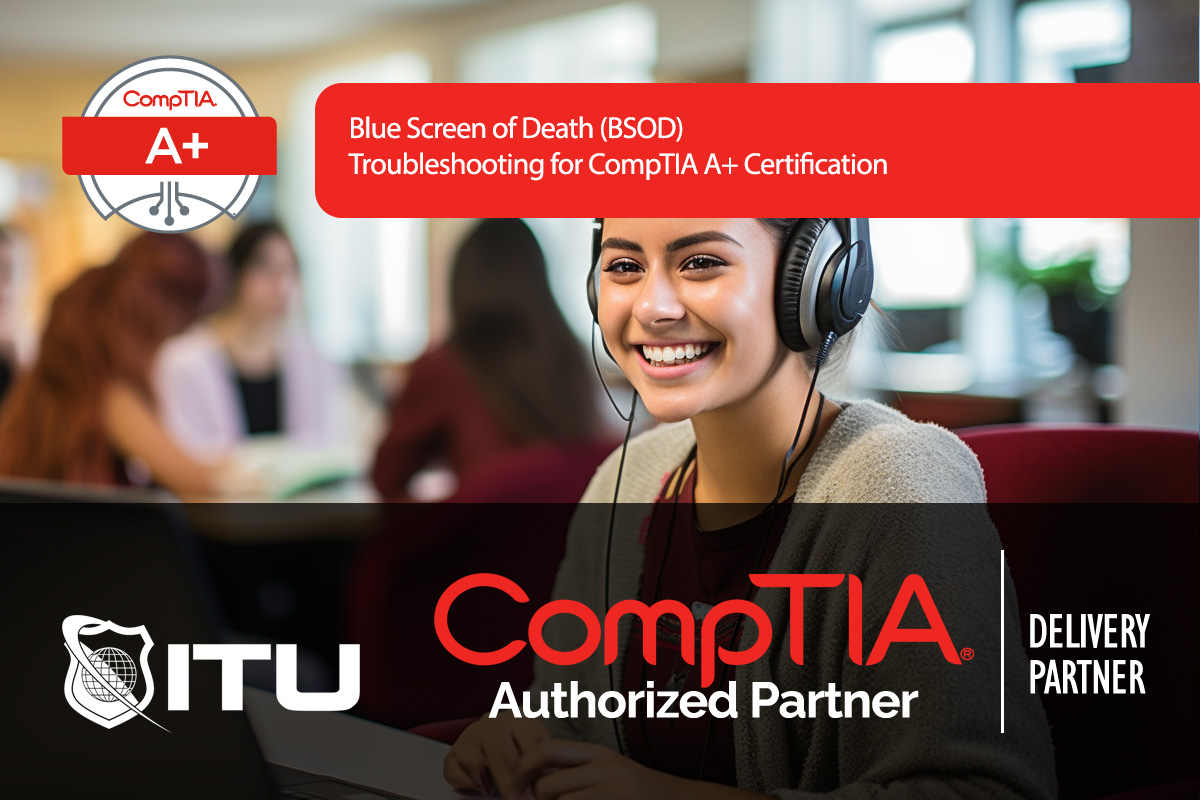What Is 3D Printing?
3D printing, also known as additive manufacturing, refers to a process of creating three-dimensional solid objects from a digital file. The creation of a 3D printed object is achieved using

The Blue Screen of Death (BSOD) is one of the most critical errors in Windows, signaling a serious hardware or software issue that forces the system to shut down. The BSOD usually occurs when the Windows kernel encounters a problem it cannot recover from, often related to hardware, drivers, or essential system files. Learning how to troubleshoot BSOD errors is crucial for CompTIA A+ technicians, as they’re likely to encounter this issue during their careers.
The BSOD, also known as a Stop Error, can be triggered by various factors, including:
Knowing the likely causes of a BSOD helps technicians identify appropriate troubleshooting steps, minimizing downtime and data loss.
Each BSOD provides a Stop Error Code (e.g., 0x0000007E) and sometimes a descriptive message (e.g., DRIVER_IRQL_NOT_LESS_OR_EQUAL). These codes help identify the root cause:
If Windows crashes before fully booting, Safe Mode provides a way to load only essential drivers and services, allowing further diagnosis.
Incompatible drivers can often lead to BSODs, especially if the problem started after a recent update.
devmgmt.msc in the Run dialog. Locate the problematic driver, right-click, and choose Properties > Driver > Roll Back Driver to restore the previous version.If the BSOD occurred after adding new hardware, consider removing it to verify if it’s the cause:
Most systems have built-in diagnostic tools for testing hardware functionality.
chkdsk /f /rWhile malware is a less frequent cause of BSODs, certain malware strains can corrupt system files or interfere with critical processes.
If BSODs persist and other troubleshooting methods have failed, reinstalling the OS may be necessary. This process replaces system files and removes potential conflicts.
Some common BSOD stop codes and their likely causes include:
Microsoft and other resources offer extensive BSOD troubleshooting documentation. Enter the error code and accompanying message in the Microsoft Knowledge Base or a search engine for relevant troubleshooting guides.
To minimize the risk of BSODs, follow these preventive steps:
A BSOD, or Blue Screen of Death, is a critical error in Windows that forces the system to shut down to prevent data corruption. It often occurs due to driver issues, hardware problems, or system file corruption, and includes a Stop Error code for troubleshooting purposes.
Each BSOD displays a Stop Error code and, sometimes, an error message. Note the code, use it to search the Microsoft Knowledge Base, or reference a troubleshooting guide. This information can pinpoint issues with drivers, hardware, or the operating system.
Yes, Safe Mode loads minimal drivers, allowing you to troubleshoot BSODs caused by recent driver updates or software changes. You can uninstall problematic drivers or run system diagnostics without interference from non-essential software.
To roll back a driver, open Device Manager (type “Device Manager” in the search bar), right-click the device with the problematic driver, select Properties > Driver, and click “Roll Back Driver.” This restores the previous driver version, often resolving BSODs related to recent updates.
If BSODs persist, try running hardware diagnostics, checking for malware, updating or rolling back drivers, and verifying hardware compatibility. If these steps don’t help, consider reinstalling Windows to reset system files and configurations.
In participation with our Udemy Partner, enroll in the newest CompTIA A+ 2025 training course for only $12.99
Lorem ipsum dolor sit amet, consectetur adipiscing elit. Ut elit tellus, luctus nec ullamcorper mattis, pulvinar dapibus leo.
$49.99 Original price was: $49.99.$16.99Current price is: $16.99. / month with a 10-day free trial
3D printing, also known as additive manufacturing, refers to a process of creating three-dimensional solid objects from a digital file. The creation of a 3D printed object is achieved using
Access Management refers to the processes and technologies designed to control and manage access to information and systems within an organization. It plays a critical role in ensuring that the
An Ad Hoc Network is a decentralized wireless networking paradigm that allows individual devices to communicate directly with each other without relying on a pre-existing infrastructure, such as routers or
Adaptive User Interfaces (AUIs) are intelligent systems designed to improve user interaction with software applications by automatically adjusting their layout and elements based on the user’s needs, preferences, and context.
Adobe Photoshop is a powerful digital imaging and graphics editing software developed by Adobe Inc. It’s widely recognized as the industry standard for raster graphics editing, used by professionals in
Agile Business Analysis (ABA) is a methodological approach that focuses on delivering business value by integrating business analysis processes with agile principles. It emphasizes flexibility, continuous improvement, and close collaboration
Agile Project Portfolio Management (PPM) is an approach that aligns project, program, and portfolio management practices with agile methodologies. It focuses on flexibility, continuous improvement, and the ability to adapt
Agile Test Automation refers to the practice of automating the testing process in an agile software development environment. It aims to enhance the efficiency and effectiveness of testing by automating
AI Governance is a framework or system designed to ensure the responsible development, deployment, and use of artificial intelligence (AI) technologies. It encompasses a broad set of policies, principles, and
Algorithmic bias refers to systematic and repeatable errors in a computer system that create unfair outcomes, such as privileging one arbitrary group of users over others. This bias can originate
Amazon Web Services (AWS) is a comprehensive, evolving cloud computing platform provided by Amazon that includes a mixture of infrastructure as a service (IaaS), platform as a service (PaaS), and
Continuous Data Protection (CDP), also known as real-time data protection, refers to the method of backing up data by automatically saving a copy of every change made to that data,